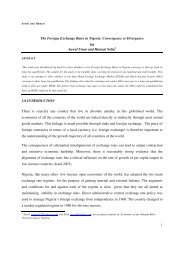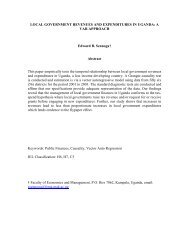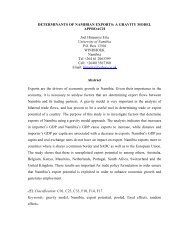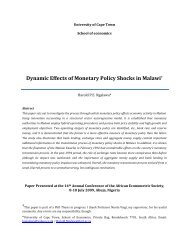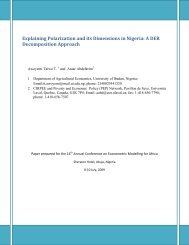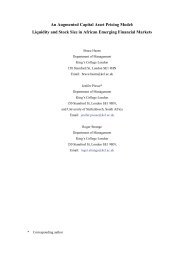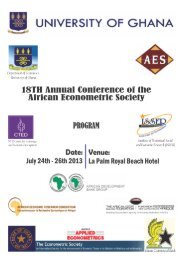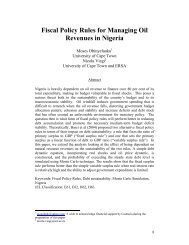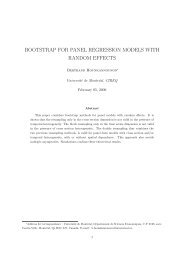The risk-return relationship in the South Africa stock market - African ...
The risk-return relationship in the South Africa stock market - African ...
The risk-return relationship in the South Africa stock market - African ...
You also want an ePaper? Increase the reach of your titles
YUMPU automatically turns print PDFs into web optimized ePapers that Google loves.
also <strong>in</strong>stances where Generalised Method of Moments (GMM) is used such as <strong>in</strong>Guo and Whitelaw (2001). Ghysels, Santa-Clara and Valkanov (2004) <strong>in</strong>troduce <strong>the</strong>Mixed Data Sampl<strong>in</strong>g (MIDAS) approach, which forecasts monthly variance with pastdaily squared <strong>return</strong>s. Although most studies use monthly data, <strong>the</strong> use of dailydenom<strong>in</strong>ated data is also prevalent. Intraday and quarterly data features <strong>in</strong> somestudies such as Balios (2008) and Guo (2002), respectively. Data span variesconsiderably with Ghysels, Santa-Clara and Valkanov (2004) as well as Lundblad(2004) employ<strong>in</strong>g <strong>the</strong> longest, which cover 76 and 68 years, respectively.3 Methodology and data3.1 ModelFollow<strong>in</strong>g Merton’s (1973) s<strong>in</strong>gle factor <strong>risk</strong>-<strong>return</strong> framework, <strong>the</strong> follow<strong>in</strong>g estimableversion of equation [3] is estimated to establish <strong>the</strong> <strong>relationship</strong> between <strong>market</strong> <strong>risk</strong>premium and <strong>stock</strong> <strong>return</strong>s:2rm, trf , t 0 mm,t m,t [4]where r is <strong>the</strong> <strong>market</strong> <strong>return</strong> and r is <strong>the</strong> <strong>risk</strong>-free rate of <strong>return</strong> so that r r ism<strong>the</strong> excess <strong>market</strong> <strong>return</strong>.2mfis <strong>the</strong> variance of excess <strong>market</strong> <strong>return</strong>. mis <strong>the</strong> whitenoise error term, 0is <strong>the</strong> <strong>in</strong>tercept term and mapproximates <strong>the</strong> coefficient of<strong>market</strong> <strong>risk</strong> aversion. As implied by <strong>the</strong> <strong>the</strong>oretical model, <strong>the</strong> <strong>in</strong>tercept is restricted tozero and <strong>the</strong> coefficient of <strong>market</strong> <strong>risk</strong> aversion is positive. Accord<strong>in</strong>g to Merton(1980), <strong>the</strong> s<strong>in</strong>gle factor <strong>risk</strong>-<strong>return</strong> model can reasonably approximate <strong>the</strong> trade-offbetween time-vary<strong>in</strong>g <strong>risk</strong> premium and <strong>stock</strong> <strong>return</strong>s and has become <strong>the</strong> standardmodel <strong>in</strong> empirical f<strong>in</strong>ance literature.mfEquation [4] is estimated directly us<strong>in</strong>g <strong>the</strong> General Autoregressive ConditionalHeteroscedasticity <strong>in</strong> mean (GARCH-M) model by Engle, Lilien and Rob<strong>in</strong>s (1987).This model has received considerable popularity <strong>in</strong> <strong>the</strong> <strong>risk</strong>-<strong>return</strong> trade-off empiricalliterature because <strong>the</strong> GARCH type conditional variance is handy as a representation4



